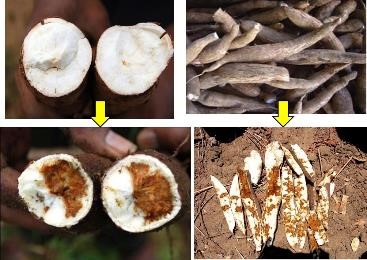More than a third of sub-Saharan Africa’s potential cassava harvest is lost to pests and diseases. The most important of these are viruses; cassava mosaic geminiviruses (CMGs) and cassava brown streak viruses (CBSVs). Greater than half of all cassava plants in sub-Saharan Africa are infected by CMGs that cause cassava mosaic disease (CMD).
The spread of an unusually severe form of CMD was first recorded in Uganda in the late 1980s and has subsequently spread to affect more than 4 million km2 across 11 countries of East and Central Africa. Production losses are estimated at 47%, with annual economic losses of more than USD 1.25 billion. These losses impact the food security of millions in sub-Saharan Africa, resulting in hunger and recurrent famines.
NRI, in collaboration with its partners, has worked to control the CMD pandemic in East and Central Intensive R&D programmes were subsequently carried out by NRI and its partners to understand the nature and extent of the vector-borne disease spread, identify cassava varieties resistant to the new virus, as well as the first ground-breaking research into why populations of the African cassava whitefly (Bemisia tabaci) that had also increased dramatically. These efforts, along with African National Research Organisations, international research institutes, and universities, contributed to the restoration of cassava cultivation in Uganda by the late 1990s, and increased food security and income generation in the eastern African region. A more recent epidemic of Cassava Brown Streak Disease (CBSD), caused by CBSVs, is currently spreading throughout East and Central Africa with devastating consequences. African cassava whitefly populations in the affected regions of East and Central Africa continued to increase and become super-abundant, leading to increased spread of CMD and CBSD. Specifically, CBSD has become the biggest constraint for cassava production in eastern Africa for the last decade, causing annual losses of over USD 736 million to smallholder farmers. CBSD causes rotting of affected roots making them unfit for human consumption or industrial use. CBSD was once considered to be benign, but since 2004 the disease has spread to more than 10 eastern and Central African countries, affecting food and income security.
CBSD research funded by the European Commission’s Food Security Thematic Programme (FSTP) Cassava Growth Markets and European Commission African Union LimitCBSD projects with research, enterprise, and NGO partners in Ghana, Nigeria, Kenya, Tanzania, Uganda, and Malawi has sought to find solutions. This has involved:
- Identifying key factors for the rapid spread of the disease through field surveys and research to understand the presence of high numbers of insect vectors (whiteflies) early in the cropping season.
- Developing Innovative diagnostic methods for virus infections to enable the isolation and detection of several viruses simultaneously.
- Producing cassava varieties that are free from viruses using tissue culture.
- Cleaning virus-infected cassava varieties using innovative methods developed by NRI such as virus indexing, chemo- and thermo-therapies, and tissue culture techniques. This was the first instance of successfully cleaning cassava germplasm from infections caused by both DNA (CMD) and RNA (CBSD) viruses.
- Making available the cleaned varieties to five CBSD-endemic countries of eastern Africa to enable further multiplication and distribution to farmers.
- Identifying resistance genes in virus-resistant cassava varieties using state-of-the-art next-generation sequencing technologies (RNA-Seq).
- Transferring the resistant genes into farmer-preferred varieties through breeding in the field.
Currently, a new African Cassava Whitefly Project is seeking to provide a rigorous understanding of the causes of super-abundant cassava whitefly populations in East and Central Africa thereby creating the foundations for future, durable-control solutions.
